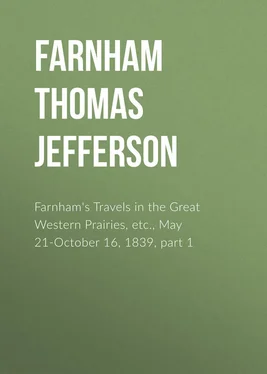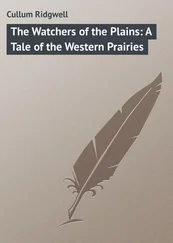Thomas Farnham - Farnham's Travels in the Great Western Prairies, etc., May 21-October 16, 1839, part 1
Здесь есть возможность читать онлайн «Thomas Farnham - Farnham's Travels in the Great Western Prairies, etc., May 21-October 16, 1839, part 1» — ознакомительный отрывок электронной книги совершенно бесплатно, а после прочтения отрывка купить полную версию. В некоторых случаях можно слушать аудио, скачать через торрент в формате fb2 и присутствует краткое содержание. Издательство: Иностранный паблик, Жанр: foreign_antique, foreign_prose, Путешествия и география, на английском языке. Описание произведения, (предисловие) а так же отзывы посетителей доступны на портале библиотеки ЛибКат.
- Название:Farnham's Travels in the Great Western Prairies, etc., May 21-October 16, 1839, part 1
- Автор:
- Издательство:Иностранный паблик
- Жанр:
- Год:неизвестен
- ISBN:нет данных
- Рейтинг книги:3 / 5. Голосов: 1
-
Избранное:Добавить в избранное
- Отзывы:
-
Ваша оценка:
- 60
- 1
- 2
- 3
- 4
- 5
Farnham's Travels in the Great Western Prairies, etc., May 21-October 16, 1839, part 1: краткое содержание, описание и аннотация
Предлагаем к чтению аннотацию, описание, краткое содержание или предисловие (зависит от того, что написал сам автор книги «Farnham's Travels in the Great Western Prairies, etc., May 21-October 16, 1839, part 1»). Если вы не нашли необходимую информацию о книге — напишите в комментариях, мы постараемся отыскать её.
Farnham's Travels in the Great Western Prairies, etc., May 21-October 16, 1839, part 1 — читать онлайн ознакомительный отрывок
Ниже представлен текст книги, разбитый по страницам. Система сохранения места последней прочитанной страницы, позволяет с удобством читать онлайн бесплатно книгу «Farnham's Travels in the Great Western Prairies, etc., May 21-October 16, 1839, part 1», без необходимости каждый раз заново искать на чём Вы остановились. Поставьте закладку, и сможете в любой момент перейти на страницу, на которой закончили чтение.
Интервал:
Закладка:
Thomas Jefferson Farnham
Farnham's Travels in the Great Western Prairies, etc., May 21-October 16, 1839, part 1
PREFACE TO VOLUMES XXVIII-XXIX
With these two volumes our series returns to Oregon, and to the question already shadowed forth upon the horizon, whether this vast territory drained by the Columbia River should belong to the United States or to Great Britain. Since the treaty of joint occupancy (1818) the English fur-traders had been in almost exclusive control. From the upper waters of the great rivers that drain the Arctic plains they had pushed their way across the Rockies down into the fertile southern valleys, and had explored, mapped, and threaded the entire region lying between Spanish territory on the south and Russian on the north. Between the great mountain barrier on the east, and the Pacific on the west, they held the country as a vast preserve in which fur-bearing animals might be reared and hunted. For many years the American right to joint occupancy lay in abeyance. After his thrilling journey of exploration and adventure, Jedediah S. Smith was cordially received at Fort Vancouver (1828), his injuries by predatory Indians avenged, and his furs purchased by the company's factor; in return for this courtesy, however, he considered himself in honor bound to restrict the further trapping enterprises of his firm to the eastern side of the Rocky Mountains. When Captain Bonneville, with his band of trappers, reached the forts on the upper Columbia (1833) he was courteously but firmly refused the privilege of trading at posts of the Hudson's Bay Company. Thus, fifteen years after joint occupancy had been arranged, there was scarcely an American in Oregon.
In our volume xxi we traced the rise and fall of the trading adventures to this far Western territory of Captain Nathaniel Wyeth of Massachusetts. His two expeditions left on the Willamette River a small residuum of New Englanders, and before his departure he had seen the coming of the first American missionaries, pioneers then as now in advancing American interests. The existence of Oregon had now come to be known to a considerable body of our people, its fertility and beauty had been enlarged upon by several writers, its advantages pictured, and its possession desired.
In returning to the United States, one of the missionaries, Jason Lee, undertook a tour through the border states of the West, lecturing and raising funds for his work. In the autumn of 1838 he stopped at the Illinois town of Peoria, where his glowing descriptions of the land whence he came produced an impression sufficiently lasting to result in the organization of an emigration society, which prepared to set forth for this land of promise early the following spring. Among the band was a young Vermont lawyer, Thomas Jefferson Farnham, who a few years earlier had removed to Illinois, and who now sought on the Western prairies recuperation of his wasting health through outdoor exploits and change of scene. He also avowed a patriotic purpose to take possession of this fair territory of Oregon for the American flag, and to aid in resisting the British fur-trade monopoly. His address and eloquence won him the honor of being chosen captain of the small band of nineteen adventurers, none of whom knew aught of wilderness life or was prepared to endure the hardships of the proposed journey.
Notwithstanding the serious purpose expressed in the motto worked by Mrs. Farnham upon the flag of the little company – "Oregon or the Grave" – they set forth in a holiday mood, ill-equipped for traversing the vast and rugged spaces lying between Illinois and the Pacific Slope. Each member of the "Oregon Dragoons," as they styled themselves, was expected to furnish $160 in money to serve for outfit and provisions.
The thirtieth of May, 1839, found them leaving Independence, on the western border of Missouri, provided with "bacon and flour, salt and pepper sufficient for four hundred miles," as well as the necessary arms and ammunition carefully packed on horses and mules. By the advice of two experienced fur-traders returning from the mountains, the travellers determined upon the Santa Fé trail, probably because of the escort privileges in connection with the annual caravan just setting forth. Therein they made a serious mistake, for the route across the mountains from the upper Arkansas to Snake River valley was infinitely more difficult and dangerous than the ordinary Oregon Trail, by way of the North Platte, Sweetwater, and South Pass; it was also less frequented by experienced mountain men, who could offer advice and assistance to the amateur travellers. Moreover the usual seeds of dissension and dissatisfaction had already been sown in the little party, each blaming others for the hardships and trials already experienced. Some of Farnham's followers pronounced the leader incompetent. Several deserted at the Lower Crossing of the Arkansas, preferring to follow the caravan to Santa Fé; while at Bent's Fort, on the upper trail, the remainder of the party left their leader with but four companions, one of these a man who had been accidentally wounded in crossing the plains. Of the "mutineers," who crossed to Fort St. Vrain, above Denver, the majority arrived in Oregon that or the following year.
Farnham, however, having secured a competent guide, with undiminished energy pushed on across the ranges of the Colorado mountains, through the mazes of its parks and passes, and halted awhile at Brown's Hole. This was the most difficult part of the journey. With graphic touches our author makes us feel the hardships, hunger and thirst, the Indian alarms, and the surprise and joy of meeting mountain men; while at the same time he is not oblivious to the rugged grandeur of the scenery, or the delicate tints of sunrise and sunset, and the majesty of the starlit nights among the hills. At Fort David Crockett, in Brown's Hole, two more of Farnham's comrades turned back, discouraged by the gloomy prospects, and the disheartening accounts of Oregon furnished by a returning guide. Here also Kelly, the unerring scout, was to leave the party, now consisting of but three travellers, who were under the necessity of trusting to the guidance of Shoshoni Indian "Jim" as far as the hospitable gates of Fort Hall. Here, the Shoshoni guide was exchanged for a Wallawalla, who contracted to conduct the party across the arid wastes of Snake River valley, halting briefly at Fort Boise, and leading the way over the Blue Mountains to the valley of the Wallawalla and the upper Columbia. There meeting a Christian Cayuse on his way to Dr. Whitman's mission at Waiilatpu, Farnham turned aside for a brief rest at this hospitable station, whose owners were "desirous to ask me how long a balloon line had been running between the States and the Pacific." Resting a few days under their mission roof, Farnham gives a favorable report of the activities and the success of the missionaries. Passing on his way by Fort Wallawalla down the Columbia to the Hudson's Bay Company's headquarters at Fort Vancouver, he there received the customary courtesy extended to all travellers in that distant region, this account closing our volume xxviii.
Three weeks' recuperation from the hardships of the four months of difficult journeying refreshed our traveller sufficiently to set him forth on an exploration of the settled portions of the country. He visited the Willamette valley, where he met the Methodist missionaries, and his presence furnished the opportunity to discuss the desirability of American occupation. A petition was thereupon set on foot, of which Farnham was undoubtedly the author, signed by seventy settlers of the valley, praying the United States to take them under its protection and describing the country as "one of the most favored portions of the globe." The language of the petition being much more favorable to Oregon than Farnham's later writings, these latter caused some acrimony among his Willamette hosts, one of whom told Commodore Wilkes, the following year, that a few days before Farnham left his party were lost in the woods and obliged to pass a cold and dark night, standing up to their ankles in mire, which cured the visitor of his enthusiasm for the country. 1 1 Charles Wilkes, Narrative of United States Exploring Expedition (Philadelphia 1844), iv, p. 348.
Certain it is that Farnham wrote from the Sandwich Islands early in January, 1840, that everything in the Oregon country had been much overrated except the seat of the Methodist mission. 2 2 Niles' Register , lviii, p. 242.
Интервал:
Закладка:
Похожие книги на «Farnham's Travels in the Great Western Prairies, etc., May 21-October 16, 1839, part 1»
Представляем Вашему вниманию похожие книги на «Farnham's Travels in the Great Western Prairies, etc., May 21-October 16, 1839, part 1» списком для выбора. Мы отобрали схожую по названию и смыслу литературу в надежде предоставить читателям больше вариантов отыскать новые, интересные, ещё непрочитанные произведения.
Обсуждение, отзывы о книге «Farnham's Travels in the Great Western Prairies, etc., May 21-October 16, 1839, part 1» и просто собственные мнения читателей. Оставьте ваши комментарии, напишите, что Вы думаете о произведении, его смысле или главных героях. Укажите что конкретно понравилось, а что нет, и почему Вы так считаете.












